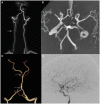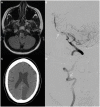Ischemic posterior circulation stroke: a review of anatomy, clinical presentations, diagnosis, and current management
- PMID: 24778625
- PMCID: PMC3985033
- DOI: 10.3389/fneur.2014.00030
Ischemic posterior circulation stroke: a review of anatomy, clinical presentations, diagnosis, and current management
Abstract
Posterior circulation strokes represent approximately 20% of all ischemic strokes (1, 2). In contrast to the anterior circulation, several differences in presenting symptoms, clinical evaluation, diagnostic testing, and management strategy exist presenting a challenge to the treating physician. This review will discuss the anatomical, etiological, and clinical classification of PC strokes, identify diagnostic pitfalls, and overview current therapeutic regimens.
Keywords: basilar artery; posterior circulation; stroke; stroke management; vertebral artery.
Figures




References
-
- Labropoulos N, Nandivada P, Bekelis K. Stroke of the posterior cerebral circulation. Int Angiol (2011) 30(2):105–14 - PubMed
Publication types
LinkOut - more resources
Full Text Sources
Other Literature Sources
Molecular Biology Databases

